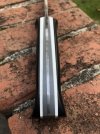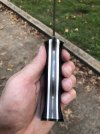ScarFoot
Knifemaker / Craftsman / Service Provider
- Joined
- Sep 16, 2021
- Messages
- 860
I’m close to finishing this knife but I had to touch up a couple of proud spots on the tang after I peened the handle scales to it. I re-etched it with FeCl on a q-tip but the pattern doesn’t show up well and now there are a few spots where you can see the etch/pattern and it just looks…bad. I thought about just sanding and polishing the spine to add contrast but I also thought about coating the spacers in nail polish and soaking the whole knife in coffee for a while. Is that crazy/risky. I’m too far along to “for science” this one so I’d like to know how the pros would handle it. Just for info the spacers are g10 and the scales are paper micarta. Everything is epoxied with G-flex.




